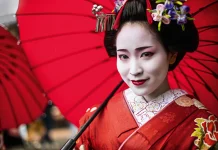Portrait of a Lady on Fire is one of the biggest movie successes of the past year and has been widely heralded for its feminist credentials. Directed and co-written by Céline Sciamma, the French-language period drama has received universal critical acclaim and numerous nominations and awards. But is the film really as feminist as many commentators claim? Here is a Feminine review of Portrait of a Lady on Fire.
The Plot
The story is set in France in 1760, and opens when a young woman, Marianne (Noémie Merlant), is sent to the island of Brittany to paint a portrait of Héloïse (Adèle Haenel) to be used in her arranged marriage. Marianne must do her work in secret, posing as a companion and eventually falling in love with her subject.
Themes of Oppression and Rebellion
At the heart of the film is the examination of oppressive societal structures that attempt to deny freedom and agency to women, both then and now. From an arranged marriage to strict social conventions, Héloïse’s life is severely restricted. In one scene, Héloïse and Marianne attempt to escape from the island, only to be found and sent back. This reflects not only the restrictions of the time, but also the way in which the patriarchy continues to oppress women today.
Achingly Beautiful Cinematography
The film is beautiful in both its content and its visual style, with breathtakingly detailed costumes, stunning shots of the coast, and a few scenes filmed on candlelit sets. Much of the focus is on female anatomy, particularly in the nudity and sex scenes between Marianne and Héloïse. The director’s attention to detail in these sequences allows them to be both erotic and empowering.
Powerful Leads
Noémie Merlant and Adèle Haenel give exquisite performances as Marianne and Héloïse. They bring an intensity to their characters that is both captivating and heartbreaking. They exude a power, energy, and vulnerability that make the film both emotionally engaging and visually stunning.
Intimate Direction
Céline Sciamma has crafted a cinematic experience that feels both intimate and personal. This is perhaps best illustrated in the scene where Marianne and Héloïse finally embrace and kiss. The camera is still, allowing the viewer to feel the intensity of the moment without ever becoming invasive.
Masterful Use of Music
The soundtrack is made up of a selection of classical and Baroque-era pieces that perfectly fit the tone of the film. From the uplifting chorale of ‘Tuba Mirum’ to the sorrowful strains of ‘Kyrie Eleison’, the score adds an extra layer of emotion to the onscreen action.
The Power of Women
At its heart, Portrait of a Lady on Fire is a story of female empowerment. Through the course of the film, the two protagonists struggle against society and the patriarchal constraints of their time which seek to deny them love and freedom. Despite the odds, they are ultimately successful in asserting their autonomy and agency, which speaks to the power of female friendship and solidarity.
Portrait of a Lady on Fire is more than a feminist masterpiece – it is an inspiring story of female friendship and resistance to oppression. It celebrates both the beauty and strength of women, and ultimately serves as a reminder that no obstacle is insurmountable. The film is an achingly beautiful and poignant look at the bonds of love between two women of an oppressive time, and a timely reminder that women’s struggle for freedom and agency continues.
“I don’t think it’s a film that can be labeled as feminist,” Céline Sciamma has said. “It has some feminist coordinates, but it’s a powerful love story. It could be a conventional love story, but the fact that it is between two women, in fact, implies something that goes beyond the flaming of two genders in love.”
This quote succinctly captures the power of Portrait of a Lady on Fire, and the complexity of its feminist message. In the end, what is most important is not a label for the film, but an appreciation for the bravery and strength of its female leads.






























































